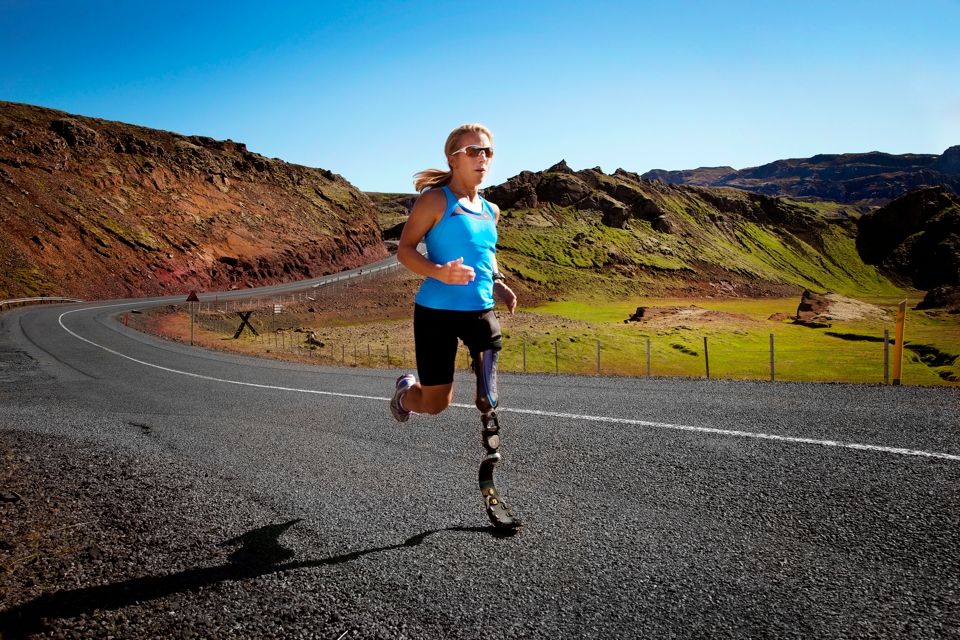Sarah Reinertsen runs. She runs a lot. And in 2005 she took part in the Hawaii Ironman race consisting of a 2.4-mile swim, a 112-mile bike ride with a 26.2-mile marathon at the end, just for good measure.
In Reinertsen’s quest to compete even harder, even stronger, and even better she has teamed up with Nike to create a new running sole.
“Previously, I would have to buy a pair of shoes, cut the sole off and stick them to the sole of the blade,” Reinertsen tells Pocket-lint over the phone; her in sunny California, we in rainy Ascot.
The blade to which Reinersten is referring is her prosthetic carbon-fibre blade that she wears for running.
You might have guessed, but Reinersten is no ordinary runner. Born with a bone-growth disorder she became an above-the-knee amputee at the age of seven. Spurred by the urge to run, she broke the 100-metre world record for female above-the-knee amputees at the age of 13.
Twenty-four years later, Reinersten and Nike have created a lightweight, durable composite sole that can be used with Össur’s Flex-Run prosthetic blade for amputee athletes.
The new Nike Sole is made up of several layers, including an outsole, midsole and thermal plastic urethane called Aeroply - made of recycled Nike Air Bag units - serving as moderator between Nike Sole and the Össur Flex-Run’s carbon fiber blade.

According to Nike, nine nylon plastic tabs serve as fingers that wrap snugly around the Flex-Run carbon fibre blade for secure lock down and easy on-off. There is also a stretch rubber leash - with a tactile grip tab for easy placement - to provide additional security.
The first Nike prototype sole used by Reinertsen was made from a Nike Free 5.0 Trail outsole, which was adhered to a plastic-based sleeve that would slide on to the blade.
“I’ve been using these soles for quiet a while, even while we’ve been developing and testing them. I’ve definitely seen them improving my performance,” says Reinertsen.
The idea is that Reinersten now has a shoe for her blade, rather than having to glue soles on to them. And that means greater success when it comes to competing.
“I race a lot internationally, and all the other athletes are always coming over to me and saying they want one, and asking me how they get one. Now they can.”
Several years in development, the new shoe for the carbon fibre blade is now available for all amputees to buy, however they won’t be able to pop into their local Nike store. Still very much associated with the medical device it fits, those interested have to get it direct from Össur.
“We need to make sure it is installed properly,” explains Reinersten.
So is the new shoe enough to insure Reinersten secures victory every time with little training? Sadly not, but a number of other training aids help.

“I’m a big tech girl. I use a Nike+ SportWatch, and the Nike+ FuelBand. I love the sports watch, but my new infatuation has been the Fuel Band,” the athlete says with glee down the phone.
If you are wondering what her daily target is, it’s 3,500 Fuel points at the moment, but she normally makes that every day she tells us - having ours set to just 3,000 now makes us feel lazy.
Other toys include a bike trainer that allows her to place her bike into a training clamp that then replicates specific courses, including that Hawaii Ironman course.
Music is also important. Like Victoria Pendleton, the British Olympic cyclist, Reinersten uses music and dedicated playlists to enhance her training and push herself harder.
“There are days that I love having an hour mix to keep me rocking at a steady pace. I am a fan of music when I run. I have all sorts of playlists that I have constructed. I used to be a spin instructor, so part of being a spin teacher is creating a playlist for your class.
"I do that in my training just for me. If I am doing intervals I will set up a couple of slamming tracks for four or five minutes at a steady rate.”
Reinersten is also a fan of Ironman athlete Chrissie Wellington’s audio training podcasts for interval training.
When we ask whether development of the shoe was complete, Reinersten tells us that the larger vision of the new Nike sole is that there will be different treads for different running environments.

“Now we have the base model we can create different types of treads that are already in sports. It is just a matter of putting them on this mould we have for the Nike Sole.
“We have always had this vision that now you can switch out your sole, you could just switch out different soles for different sports, just like you can change your shoes. Trail tread, track spike or even cleats for different sports like soccer will be possible.”
Aside from expanding the possibilities of the new shoe, Reinersten is already working on the next project with Nike and Össur, striving to enhance her performance and that of other athletes, although she is reluctant to go into specifics with us over the phone.
“As an amputee, a person that has to use a piece of technology everyday even just to walk into my kitchen to make a cup of coffee, there is a level of desire to be part of the innovation that will help me, not just in sport, but in life.” Reinersten tells us. “I want there to be more in my day-to-day life.”

